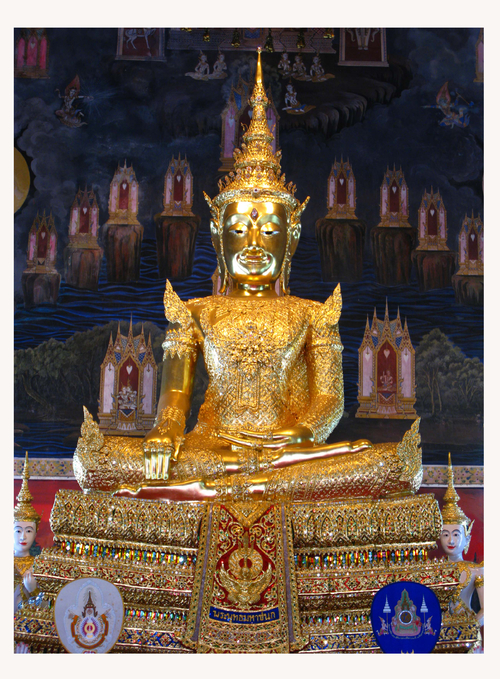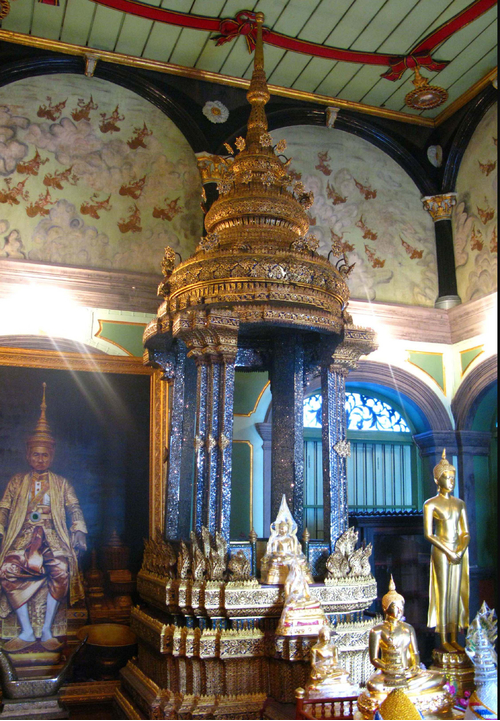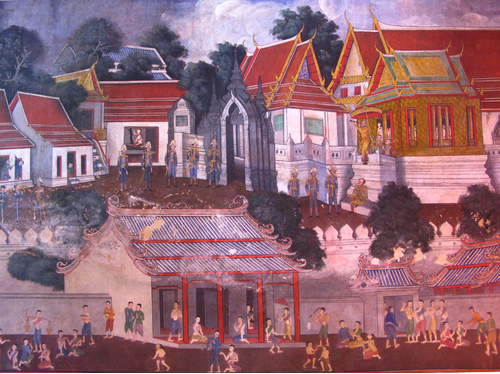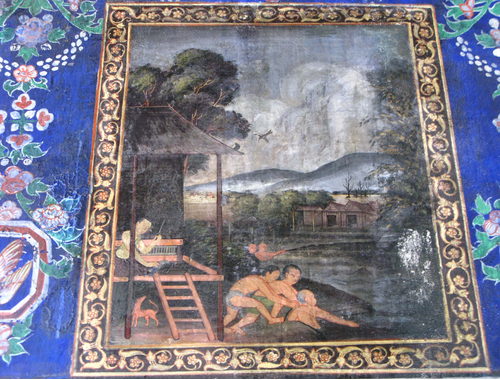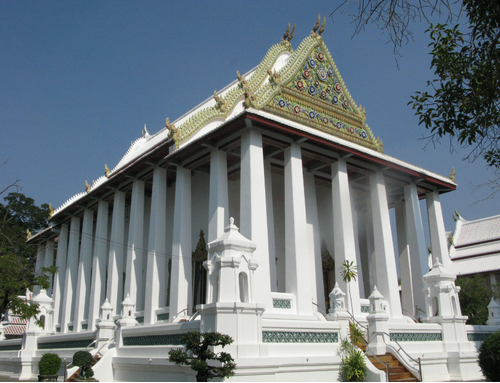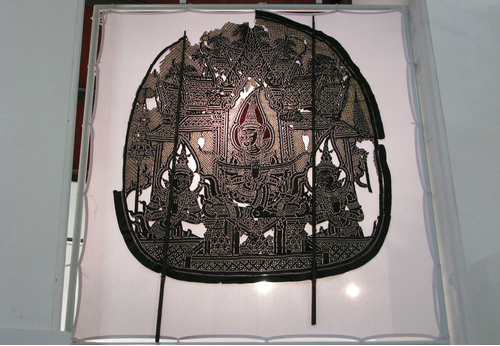ค้นหางานศิลปกรรม
ฐานข้อมูลศิลปกรรมในเอเชียตะวันออกเฉียงใต้
จิตรกรรมจิตรกรรมเรื่องมโหสถชาดก
เนื้อหาภาพจิตรกรรมเป็นเรื่องราวตามแบบแผนประเพณี เช่น เรื่องพุทธประวัติ เทพชุมนุมทศชาดก และไตรภูมิโลกสัณฐาน จึงแสดงความสมจริงตามเรื่องราวอันเป็นปรัมปราคติ แต่ในขณะเดียวกันภาพจิตรกรรมยังได้สะท้อนแนวคิดแบบสมจริงอย่างเป็นเหตุเป็นผล ที่เกิดจากทัศนคติอย่างตะวันตกที่เริ่มแพร่เข้ามาในสมัยรัชกาลที่ 3 ดังจะเห็นได้จากรายละเอียดอันเป็นความสมจริงในฉากต่างๆ ไม่ว่าจะเป็นอาคารบ้านเรือน วิถีชีวิตผู้คน ซึ่งมีสอดแทรกจากภาพที่เป็นเนื้อหาหลัก ภาพจิตรกรรมยังปรากฏเทคนิคการเขียนภาพแบบไทยประเพณี เช่น ภาพกษัตริย์ มเหสี ที่เขียนอย่างตัวพระ ตัวนางในวรรณคดีที่แสดงออกด้วยท่านาฏลักษณ์ การปิดทองคำเปลวในส่วนสำคัญต่างๆ ฉากเหตุการณ์ต่างๆ ใช้พื้นหลังสีเข้ม จึงขับเน้นให้ภาพปราสาทราชวัง อาคารบ้านเรือน รวมทั้งตัวละครที่มีสีอ่อนกว่าและปิดทองในบางตำแหน่งให้มีความโดดเด่นมากยิ่งขึ้น
ประติมากรรมพระพุทธมหาชนก
พระพุทธรูปประทับนั่งบนฐานชุกชี แสดงปางมารวิชัย ทรงครองจีวรลายดอกห่มเฉียง ประดับด้วยเครื่องทรงอื่นๆจำนวนมาก ได้แก่ มงกุฎยอดชัยหรือยอดแหลมซึ่งมีรูปแบบคล้ายเป็นการจำลองพระมหาพิชัยมงกุฎ โดยประกอบด้วยรัดเกล้า 3 ชั้นประดับดอกไม้ไหว และมีกรรเจียกจร ทรงสวมกรองศอ ทับทรวง พาหุรัด ธำมรงค์ ทองพระกร ทองพระบาท พระพักตร์สงบนิ่ง พระเนตรเหลือบต่ำ พระขนงโค้ง พระโอษฐ์แย้มเล็กน้อยซึ่งเป็นรูปแบบพระพักตร์ของพระพุทธรูปในสมัยรัตนโกสินทร์
ประติมากรรมบุษบกธรรมาสน์ยอดทรงมงกุฎ
บุษบกธรรมาสน์ยอดทรงมงกุฎประกอบด้วยส่วนฐาน ส่วนกลาง และส่วนยอด ส่วนฐานเป็นฐานสิงห์เพิ่มมุมซ้อนชั้นโดยมีท้องไม้ยืดสูง ด้านหน้ามีชั้นลดสำหรับพระสงฆ์ขึ้นสู่ธรรมาสน์ ส่วนกลางมีลักษณะโปร่ง ประกอบด้วยเสาย่อมุมไม้สิบสองที่ 4 มุมของบุษบก รองรับส่วนยอดทรงมงกุฎที่ประกอบด้วยชั้นเกี้ยวรัดเกล้าซ้อนลดหลั่น 3 ชั้น แต่ละชั้นประดับดอกไม้ไหว ถัดขึ้นไปเป็นปลียอดเรียวแหลม
จิตรกรรมจิตรกรรมเรื่องพระราชพิธีสิบสองเดือน
ภาพเขียนสีฝุ่น ใช้เทคนิคการเขียนภาพแบบตะวันตกโดยคำนึงถึงหลักทัศนียวิทยา ทำให้ภาพมีมิติและระยะใกล้-ไกล ใช้ภาพพระมหาปราสาทและอาคารต่างๆในพระบรมมหาราชวังเป็นฉากหลังในการเล่าเรื่อง ภาพอาคารบ้านเรือน ภาพการแต่งกายของบุคคลไม่ว่าจะเป็นขุนนาง ทหาร และชาวบ้าน เป็นไปตามสมัยนิยมในขณะนั้น
จิตรกรรมจิตรกรรมเรื่องฉฬาภิชาติ
เรื่องฉฬาภิชาติที่พระอุโบสถ วัดบวรนิเวศวิหาร มีจารึกปรากฏที่โคนเสาคู่หน้าใกล้พระประธานทั้ง 2 ต้น ความว่า “อนึ่งได้มีพระพุทธสุภาษิตแสดงฉฬาภิชาติไว้ดังนี้1. กัณหาภิชาติยะ บุคคลผู้เกิดมาดำ คือต่ำต้อยและขัดสน ทั้งเกิดนิยมธรรมดำ คืออกุศลจริตต่างๆ2. กัณหาภิชาติยะ บุคคลผู้เกิดมาดำ แต่เกิดนิยมธรรมขาว คือกุศลจริตต่างๆ3. กัณหาภิชาติยะ บุคคลผู้เกิดมาดำ แต่เกิดนิยมนิพพาน อันไม่ดำไม่ขาว4. สุกกาภิชาติยะ บุคคลผู้เกิดมาขาว คือสูงและมั่งมี แต่เกิดนิยมธรรมดำ5. สุกกาภิชาติยะ บุคคลผู้เกิดมาขาว ทั้งเกิดนิยมธรรมขาว6. สุกกาภิชาติยะ บุคคลผู้เกิดมาขาว เกิดนิยมนิพพาน ที่ไม่ดำไม่ขาว”ภาพจิตรกรรมเรื่องฉฬาภิชาติที่พระอุโบสถ วัดบวรนิเวศวิหาร อยู่ในกรอบสี่เหลี่ยมที่โคนเสา โดยเรียงลำดับจากเสาคู่แรกใกล้พระประธาน ได้แก่เสาคู่ที่ 1 ภาพพระพุทธเจ้าทรงรับบิณฑบาต พื้นเสาสีขาวอ่อนเสาคู่ที่ 2 ภาพพระภิกษุและนักบวช พื้นเสาสีขาว เสาคู่ที่ 3 ภาพอุบาสกอุบาสิกา นุ่งห่มด้วยชุดขาว พื้นเสาสีเหลือง เสาคู่ที่ 4 ภาพกษัตริย์ พราหมณ์ และคหบดี พื้นเสาสีแดง เสาคู่ที่ 5 ภาพตุลาการ เจ้าหน้าที่เรือนจำและนักโทษ พื้นเสาสีเขียว เสาคู่ที่ 6 ภาพคนล่าสัตว์หรือนายพราน พื้นเสาสีคราม เมื่อศึกษาข้อความจากพระไตรปิฎกร่วมกับการจัดวางตำแหน่งของภาพบุคคลแต่ละกลุ่ม ทำให้สันนิษฐานได้ว่าภาพเหล่านี้น่าจะจัดได้เป็น 3 กลุ่ม คือ1. กลุ่มที่นิยมนิพพาน ไม่ดำไม่ขาว ได้แก่ ภาพพระพุทธเจ้า ภิกษุ และนักบวชที่เสาคู่แรกและคู่ที่ 2 ใกล้กับพระประธาน ซึ่งน่าจะหมายรวมทั้งผู้ที่มีกำเนิดสูงและต่ำ แต่มีความตั้งใจที่จะออกบวชเพื่อบรรลุนิพพาน2. กลุ่มที่นิยมธรรมขาว ได้แก่ ภาพอุบาสกอุบาสิกาที่นุ่งห่มด้วยชุดขาวที่เสาคู่ที่ 2 กับภาพกษัตริย์ พราหมณ์ และคหบดีที่เสาคู่ที่ 3 ซึ่งมีความสุจริตกาย วาจา ใจ ตามฐานันดรภาพของตน โดยภาพอุบาสกนุ่งห่มขาวก็อาจหมายถึงบุคคลที่มีกำเนิดไม่ว่าจะสูงหรือต่ำต้อยแต่เลือกที่จะประพฤติดี ส่วนภาพกษัตริย์ พราหมณ์และคหบดี หมายถึง บุคคลที่มีชาติกำเนิดสูงซึ่งสอดคล้องกับข้อความในพระไตรปิฎกด้วย 3. กลุ่มที่นิยมธรรมดำ ได้แก่ ภาพตุลาการ เจ้าหน้าที่เรือนจำและนักโทษที่เสาคู่ที่4 กับภาพคนล่าสัตว์ที่เสาคู่ที่ 5ซึ่งหมายถึงบุคคลที่ทำบาป ทั้งบุคคลที่เกิดในสกุลต่ำ มีความอดอยากจึงจำเป็นต้องหาเลี้ยงชีพด้วยการฆ่าสัตว์ หรือบุคคลที่แม้เกิดในตระกูลสูงแต่เมื่อประพฤติผิดก็ย่อมถูกลงโทษ รวมทั้งบุคคลบางกลุ่มที่จำเป็นต้องทำบาปด้วยหน้าที่เช่นการเป็นผู้ตัดสินความผิดของนักโทษ หรือมีอาชีพเป็นเพชฌฆาต
ประติมากรรมปูนปั้นเรื่องพุทธศาสนาวัดบางกะพ้อม
ภาพปูนปั้นระบายสีและใช้เทคนิคการปิดทองประดับกระจกอยู่ที่บริเวณผนังทั้ง 4 ด้านของวิหารพระพุทธบาท ผนังด้านทิศตะวันออกเล่าเรื่องพุทธประวัติตอนสำคัญได้แก่ นางสุชาดาถวายข้าวมธุปายาส ลอยถาด เสด็จดับขันธ์ปรินิพพาน ผนังด้านทิศใต้เล่าเรื่องถวายพระเพลิงพระพุทธสรีระ โดยมีภาพจริยวัตรสงฆ์ประกอบร่วมอยู่ด้วย ผนังด้านทิศตะวันตกเป็นภาพพระอดีตพุทธเจ้าทั้ง 3 องค์ ผนังด้านทิศเหนือเล่าเรื่องตำนานรอยพระพุทธบาท
สถาปัตยกรรมวัดเฉลิมพระเกียรติ
พระอุโบสถ พระวิหาร อยู่ในผังสี่เหลี่ยมผืนผ้า ตัวอาคารก่ออิฐถือปูน พระอุโบสถมีขนาดใหญ่กว่าพระวิหาร มีซุ้มใบเสมาอย่างเทศทั้ง 8 ทิศ ทั้งพระอุโบสถและพระวิหารมีรูปแบบอย่างพระราชนิยมในรัชกาลที่ 3 กล่าวคือ มีเสาพาไลทรงสี่เหลี่ยมทึบไม่ประดับบัวหัวเสารองรับเครื่องหลังคาอยู่โดยรอบอาคาร และไม่มีคันทวย หลังคาซ้อนชั้นมุงกระเบื้องเคลือบ หน้าบันปรากฏอิทธิพลแบบจีน โดยเป็นหน้าบันสามเหลี่ยมเรียบ ซ้อนชั้น ประดับด้วยกระเบื้องเคลือบสีที่ประดิษฐ์เป็นลายดอกพุดตานก้านแย่งสลับใบ กรอบหน้าบันไม่ประดับเครื่องลำยอง จึงไม่ปรากฏช่อฟ้า ใบระกา และหางหงส์ แต่ทำเป็นรูปเศียรนาคแทน
จิตรกรรมหนังพระนครไหว
หนังพระนครไหวประกอบด้วยหนัง 2 ประเภทใหญ่ ได้แก่ หนังชุดเบิกโรง คือชุดจับลิงหัวค่ำ ประกอบด้วยตัวหนังพระฤษี ลิงขาว และลิงดำ อีกประเภทหนึ่งคือหนังเล่าเรื่อง สำหรับการแสดงเรื่องรามเกียรติ์ตอนต่างๆ เช่น ตอนศึกอินทรชิตตอนหักคอช้างเอราวัณ ตอนหนุมานอาสา ตอนทศกัณฐ์สั่งเมือง และตอนพระรามเสี่ยงม้าอุปการเป็นต้น ตัวหนังทำจากหนังโคเป็นผืนขนาดใหญ่ ฉลุลายด้วยสิ่วและค้อนให้เป็นรูปตัวละครจากเรื่องรามเกียรติ์และองค์ประกอบต่างๆ ตามท้องเรื่อง ตัวละครแต่งกายยืนเครื่องและสวมศิราภรณ์เช่นเดียวกับการแสดงโขน โดยแผ่นหนังทั้งผืนไม่ขาดจากกัน ระบายสีผืนหนังในบางแห่ง หนังแต่ละตัวมีไม้คีบหนัง 2 ข้าง สำหรับผนึกตัวหนังและเชิดประกอบการแสดง

